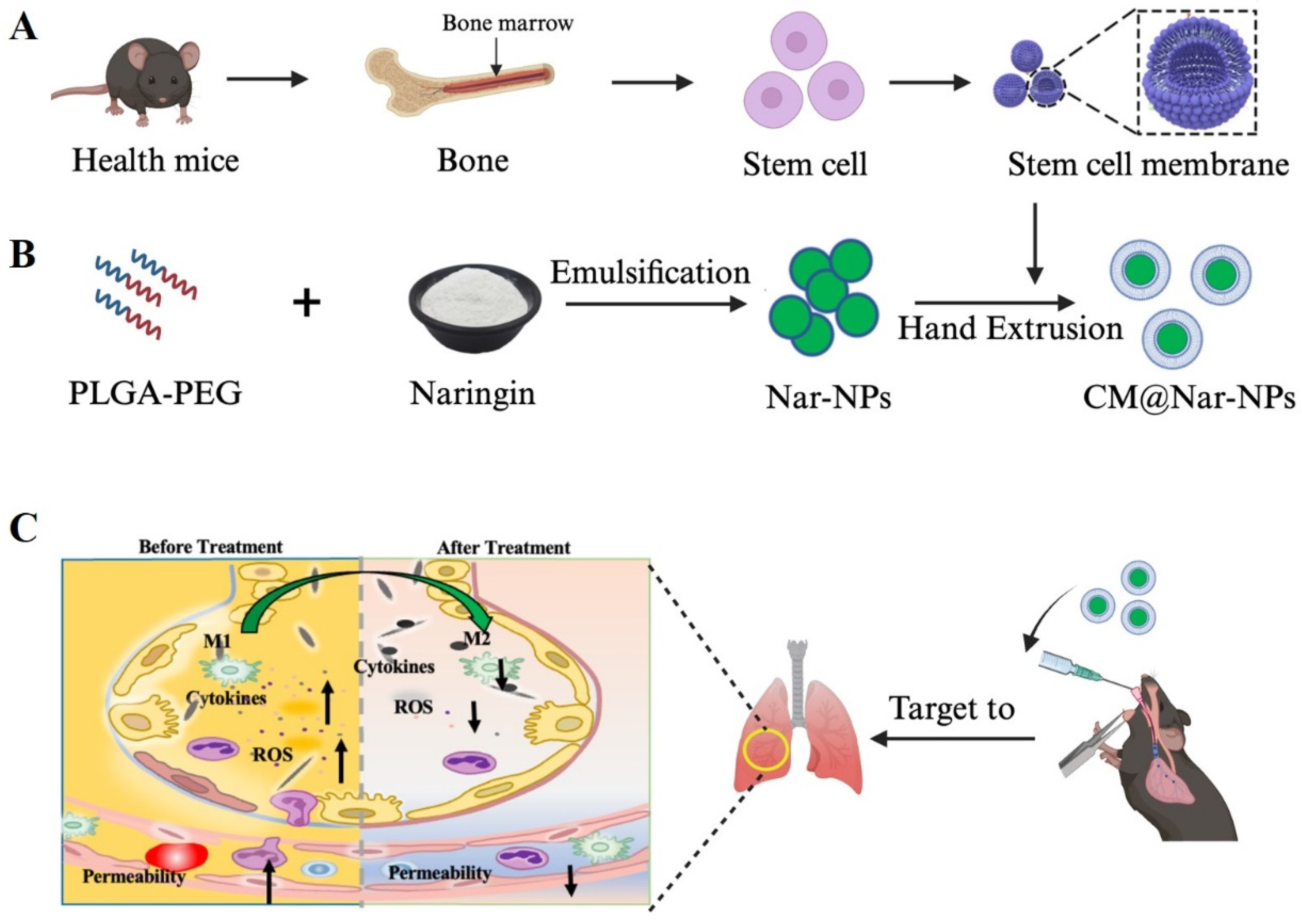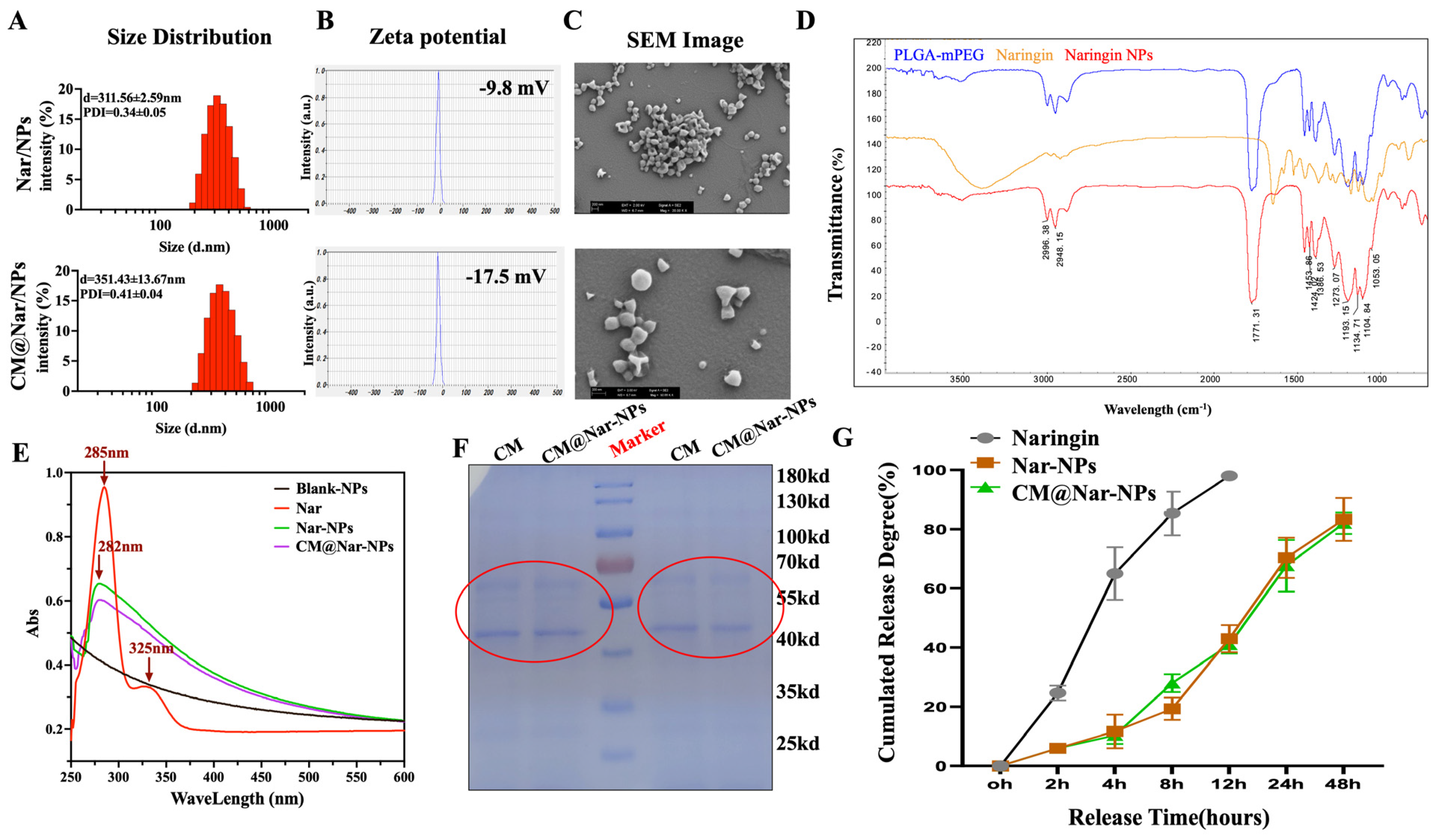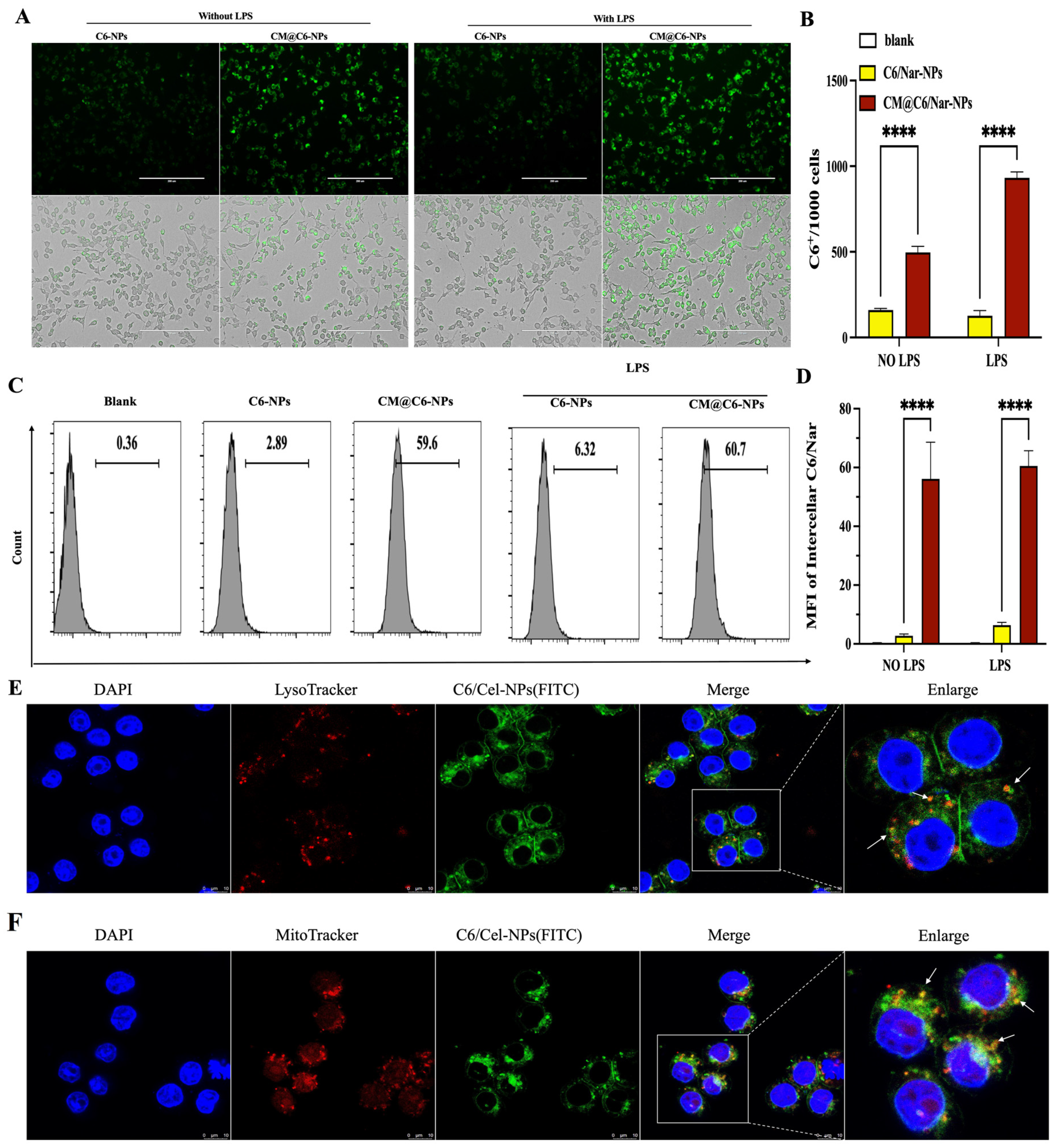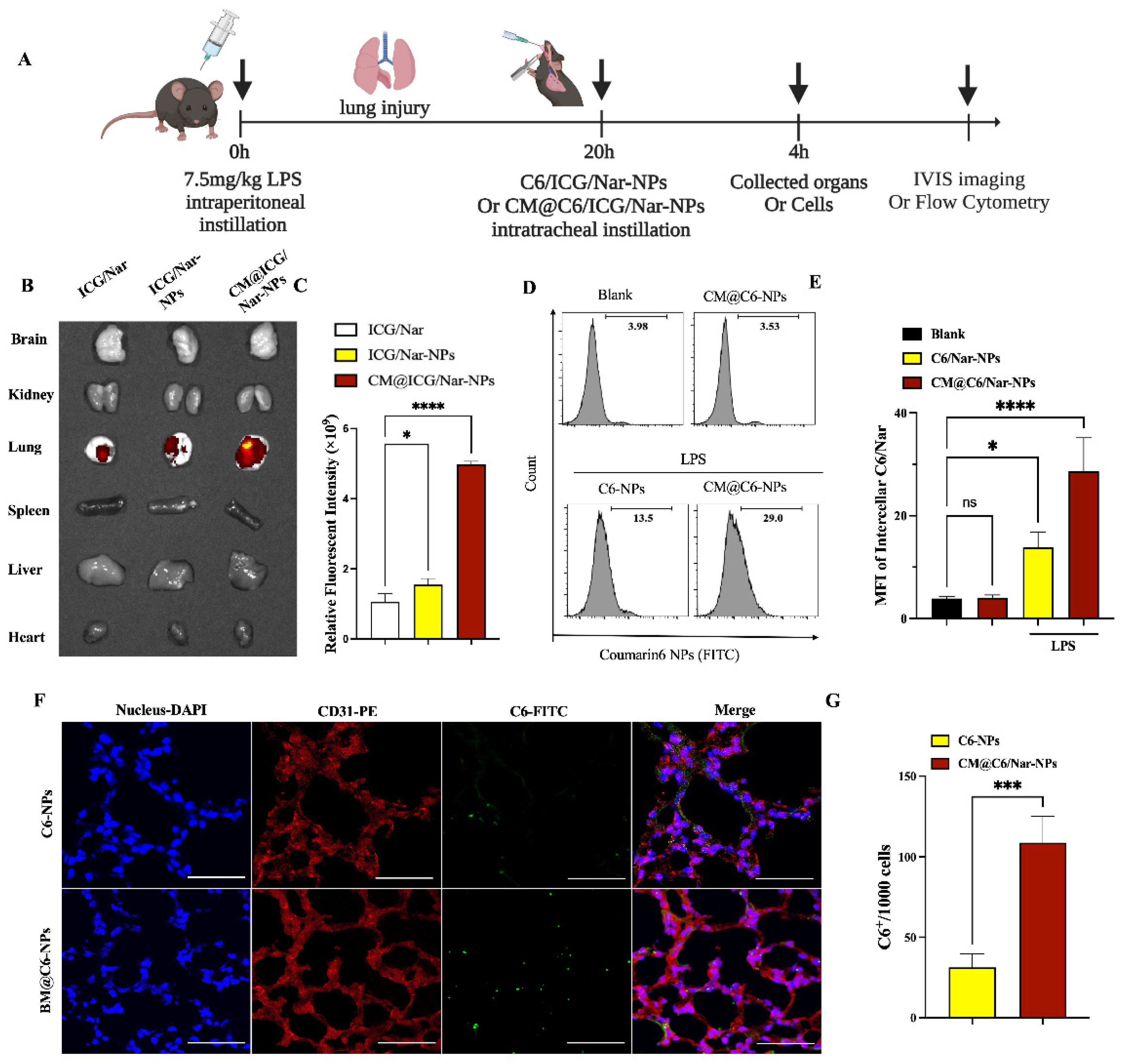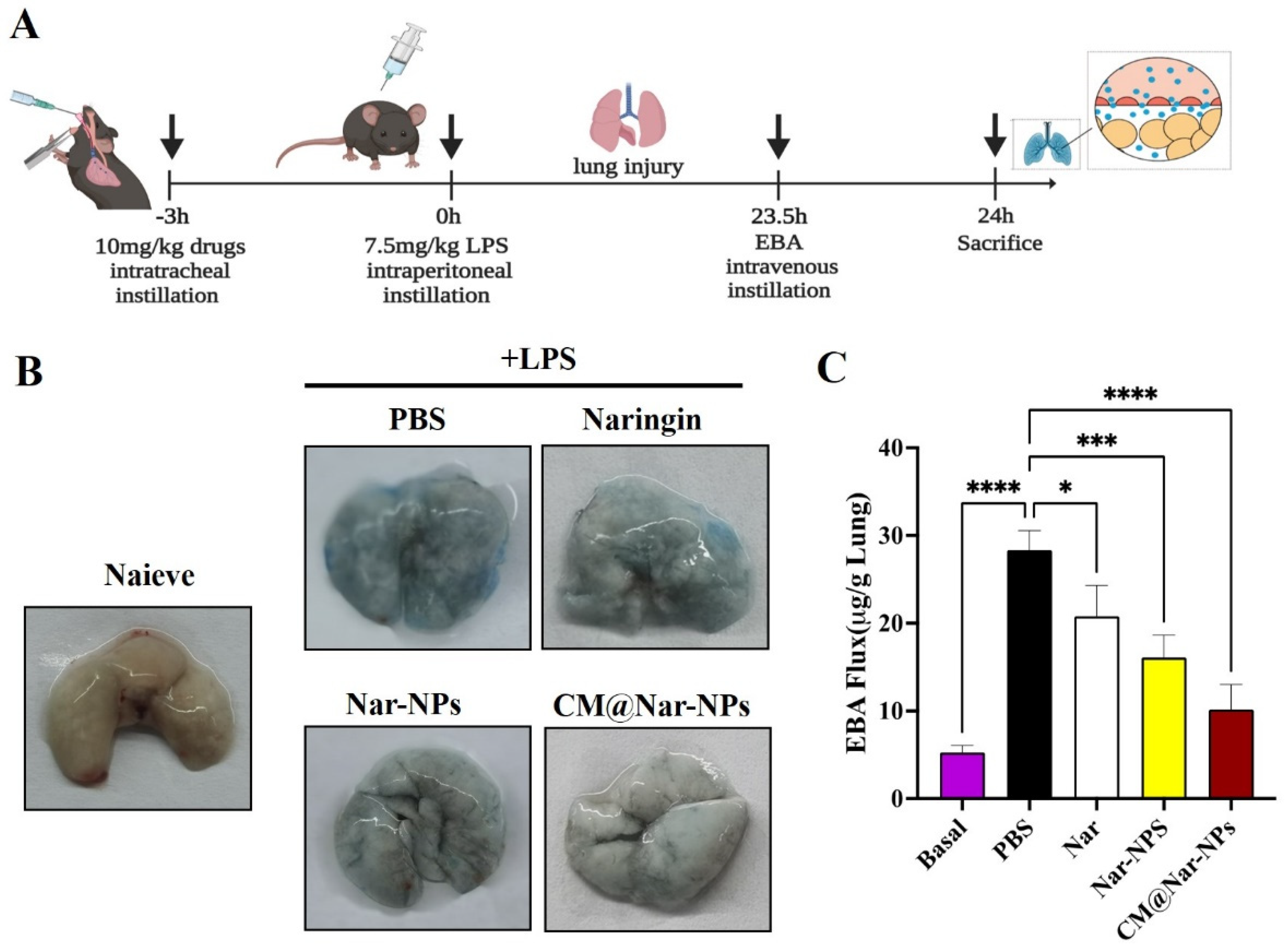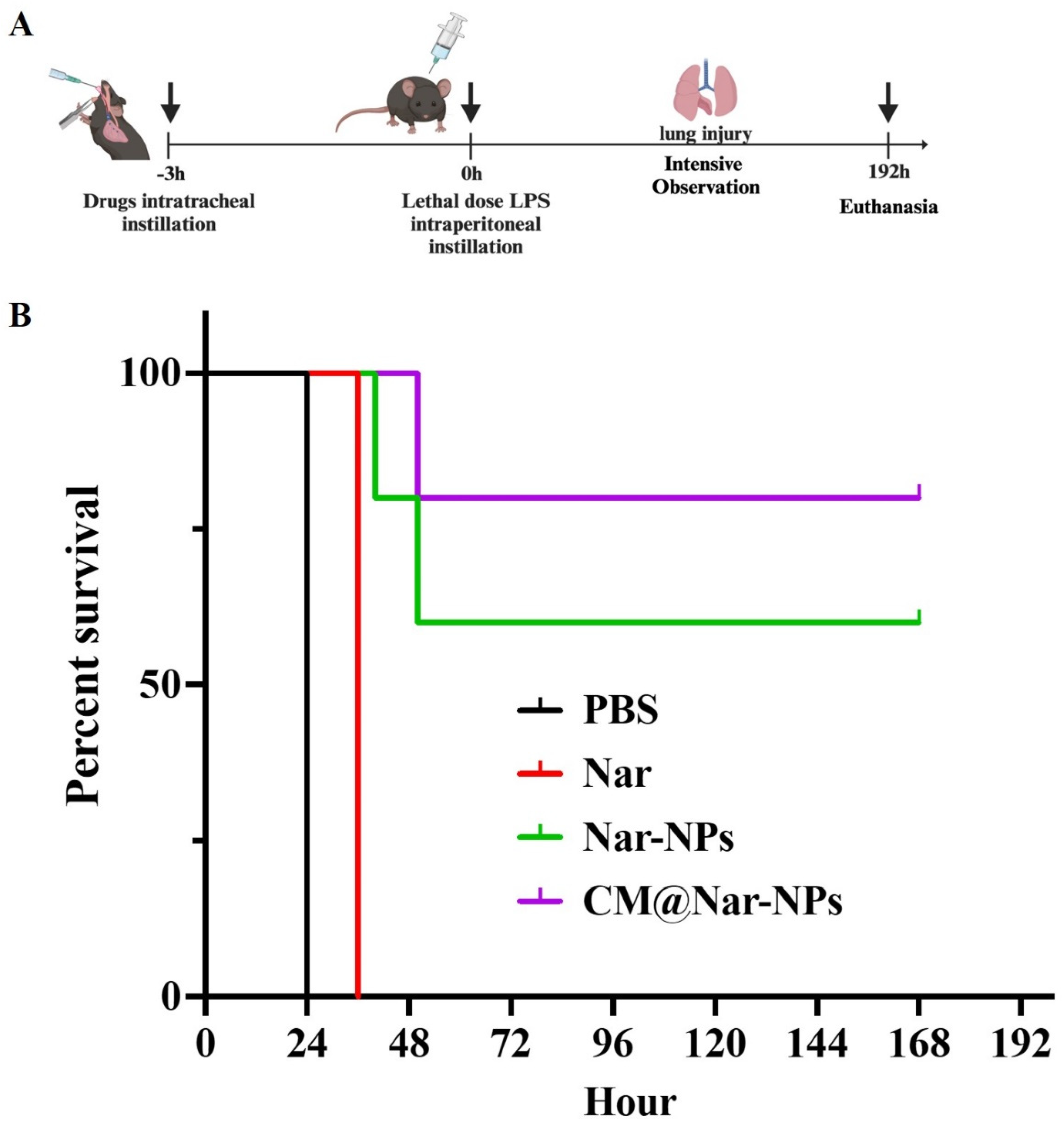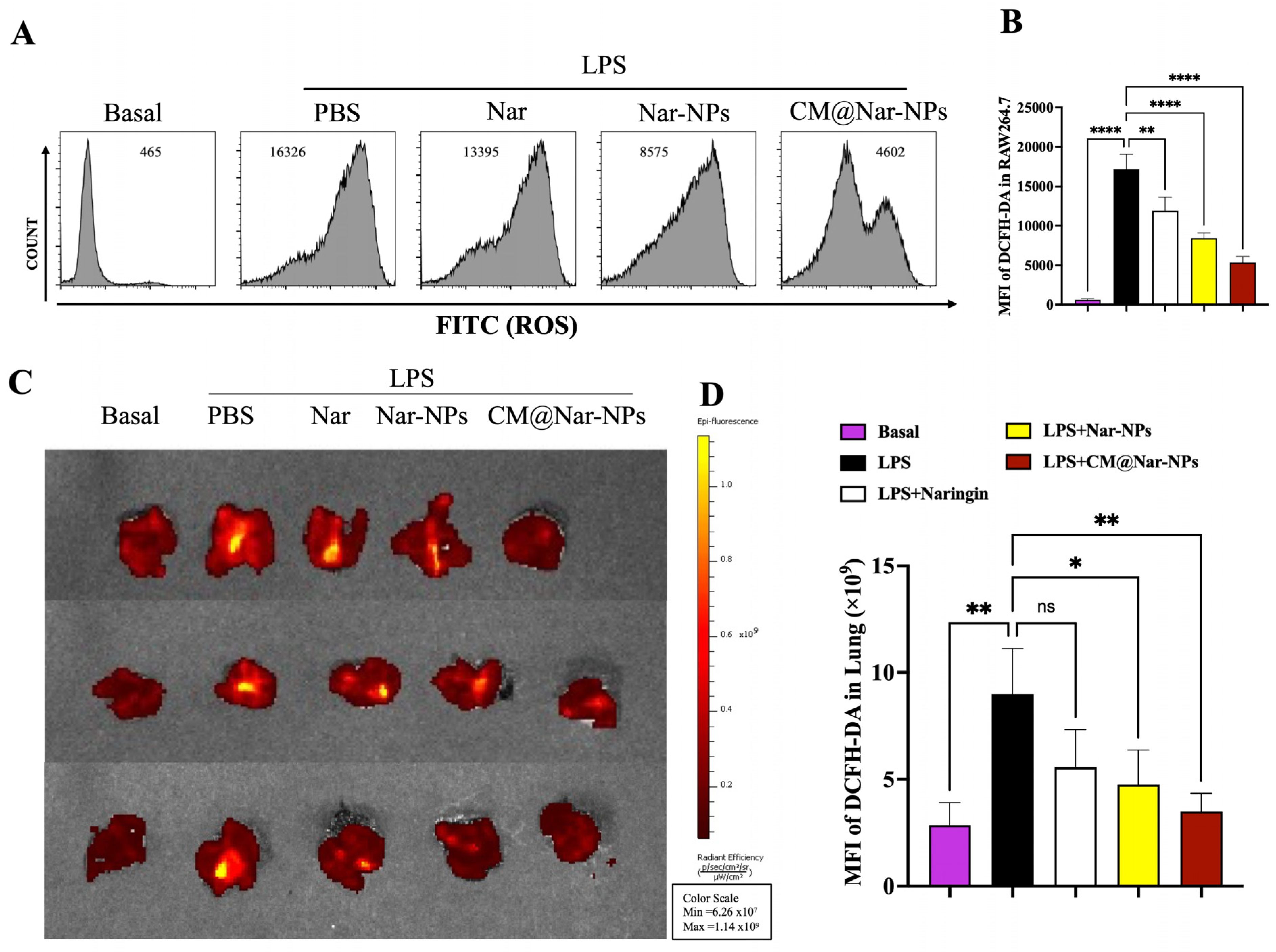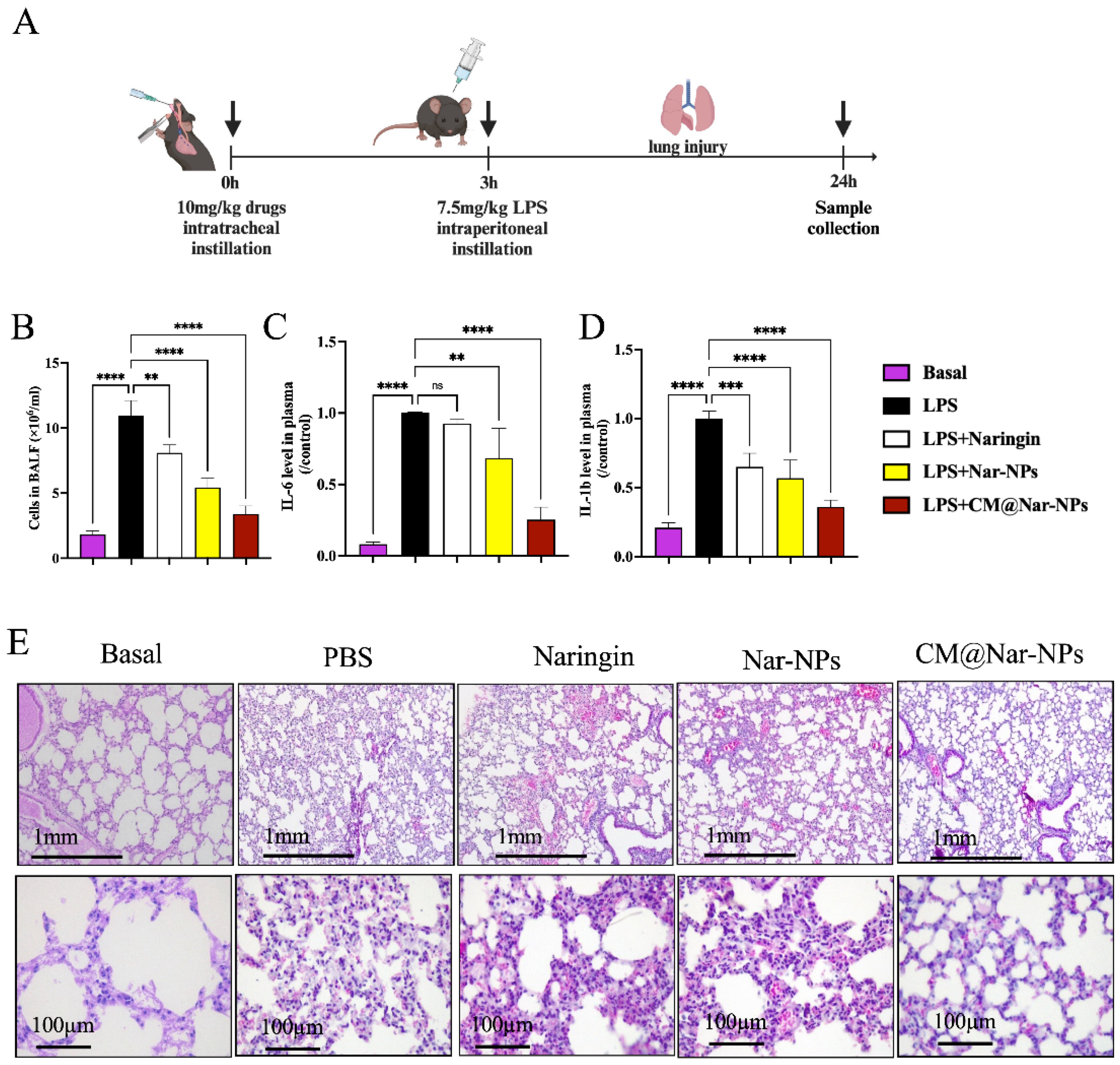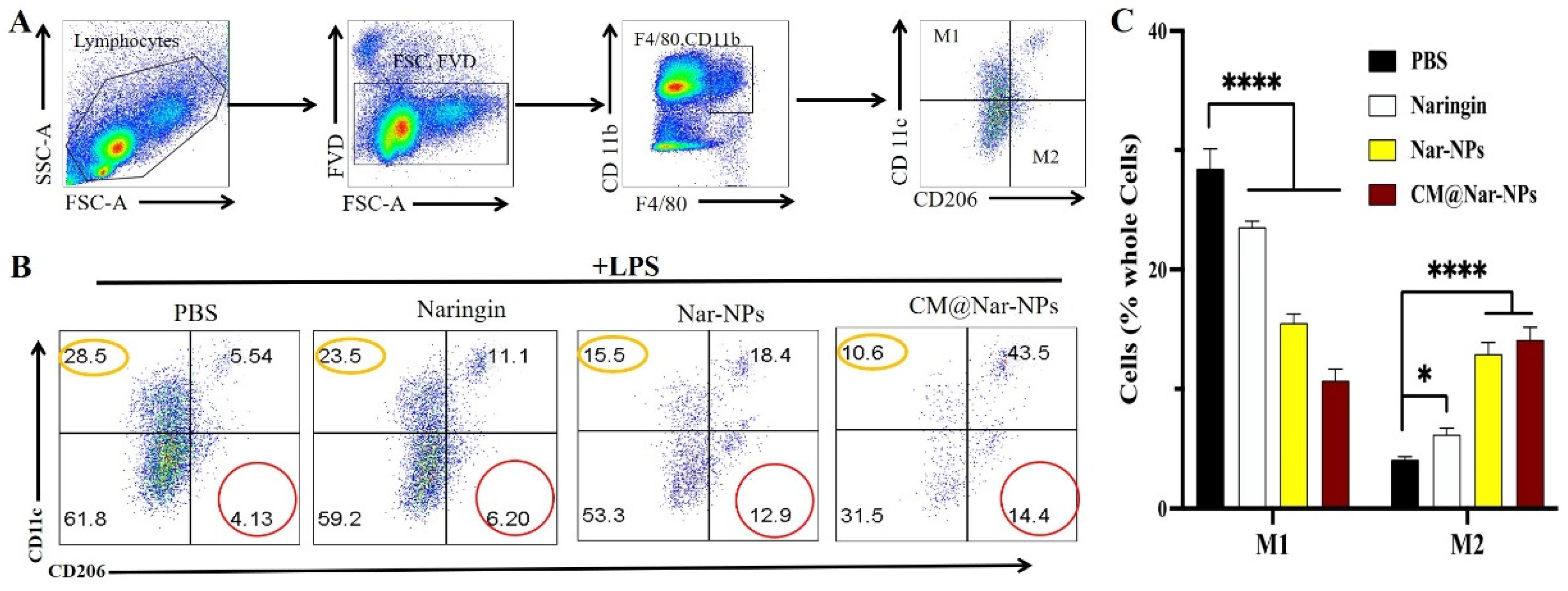1. Introduction
Cytokine storm is an overactivation of the immune system caused by infections, drugs, etc., which can occur rapidly and lead to organ failure, life-threatening conditions, and even death [
1]. In the COVID-19 epidemic, most patients with COVID-19 developed acute respiratory distress syndrome (ARDS) [
2,
3,
4], multiple organ failure [
5], and even death. It is noticeable that one of the most important mechanisms underlying the deterioration of this disease is cytokine storm release syndrome (CRS). CRS occurs in the pulmonary airways and develops into severe pneumonia, such as ALI (acute lung injury) and/or ARDS [
6]. Additionally, reactive oxygen species (ROS) is closely associated with organ damage in ALI [
7]. The overproduction of ROS could induce the activation of lung macrophages and infiltration of neutrophils, and simultaneously invade and spread into lung epithelial and endothelial cells, which promptly leads to tissue damage and organ dysfunction [
8]. Thus, effectively controlling the CRS and scavenging the ROS are key strategies for treating severe pneumonia and other serious infectious diseases.
Currently, glucocorticoids, antibiotics, neutralizing antibodies (such as anti-IL-6), and stem cell-based therapies are mainly employed in clinics to calm the CRS and treat CRS-induced pneumonia [
9,
10,
11]. Although these therapeutics exert highly effective anti-inflammatory merits, the off-targeting effect determines their different degrees of systemic immunosuppressive side effects [
12]. Currently, there is no specific treatment for ALI/ARDS. In clinics, the main supportive measures include protective lung ventilation and restrictive fluid resuscitation, among others. Although supportive treatment can alleviate patients’ clinical symptoms, it does not significantly improve their prognosis. The mortality rate of sepsis-induced ALI/ARDS remains as high as 46.1% [
13].
Therefore, finding new targets and developing targeted strategies are of great significance for controlling clinical pneumonia from mild to severe, reducing severe mortality, shortening hospitalization time, and improving the life quality of patients. Plants are the most abundant organisms on Earth in terms of biomass. Compounds and natural products derived from plants have been widely used for the treatment of various diseases. Naringin (Nar), a natural bioactive flavanone, which is rich in grapefruits, shows fabulous antioxidant and anti-inflammatory properties. Previous studies indicated that Nar could attenuate airway inflammation and ameliorate lung dysfunction [
14], while the poor solubility and off-targeting of Nar greatly limit its therapeutic efficiency. Thus, targeted delivery of Nar into the inflammation lesions is a key strategy to increase its anti-inflammation efficacy.
Biodegradable nanoparticle-based delivery systems have been emerging as attractive pharmacological vehicles to improve bioavailability and biocompatibility of drugs due to their enhanced water-solubility and sustained and controlled release properties [
15]. However, nanoparticle capture and elimination by the immune system are great obstacles to drug delivery. Currently, the cloaked nanoparticles with cell membranes represent a promising strategy to evade phagocytosis and avoid immunogenicity by the immune system. This kind of biomimetic nanoparticles simultaneously possesses the functions of drugs loaded in nanoparticles and the biological functionalities of the source cells inherited from the cell membranes. As expected, the cell membrane-cloaked nanoparticle-delivery system could evade immune elimination, prolong circulation time, and even target to disease regions by the nature of the homing ability of the cells [
16]. In the past decades, stem cells have been studied and utilized for repair and regenerative medicine [
17]. The inherent properties of stem cells determine that the stem cell-based biomimetic nanoparticles can be effectively targeted to tumor or inflammatory sites, which provide sustained circulation and boosted drug accumulation at target sites, augmenting therapeutic efficacy and safety [
18]. Additionally, stem cells can be obtained from various sources, including bone marrow, amniotic cells, adipose tissue, umbilical cord, and placental tissue. Stem cell membrane functionalized nanoparticles combine anti-inflammatory and antimicrobial drugs indicating excellent therapeutic effects for sepsis treatment [
19].
Traditional anti-inflammation drugs are mainly administered orally or by injection, but these administration methods always bring issues of adverse reactions in the liver and gastrointestinal tract, as well as the development of drug resistance with long-term use. In pulmonary diseases, the lung is the main targeted organ to achieve drug local delivery. Thus, delivering drugs directly to the target site through the bronchial-pulmonary route can not only enhance drug efficacy but also reduce the occurrence of adverse reactions and drug resistance. Researchers comprehensively compared the therapeutic activity, biodistribution, and lung cell targeting characteristics of three anti-inflammatory drug delivery routes—
intratracheal (
i.t.),
intravenous (
i.v.), and
intraperitoneal (
i.p.) [
20]. The results indicated that
i.t. administration of NPs exhibited excellent efficacy in the ALI treatment compared with other administrated methods.
Although most Chinese herbal medicines, such as Nar, exhibit potent anti-inflammatory and antioxidant activities at the cellular level, their clinical efficacy and application are greatly limited due to their poor water solubility, low bioavailability, off-target effects, and difficulties in cellular uptake. Thus, in this work, to overcome these disadvantages, stem cell membrane-cloaked PLGA NPs were synthesized and delivered Nar to the inflammatory lesions in vivo. We successfully constructed a herbal ingredient (Nar) loading PLGA NPs for ALI management. The Nar-NPs were further modified with LPS-treated bone marrow derived-mesenchymal stem cell (BMSC) membrane, to exert targeting delivery to the inflammatory microenvironments. The biocompatibility, inflammation-targeting, antioxidant capacity, and anti-inflammatory efficiency were determined both in vitro and in vivo. The as-synthesized biomimetic platform (CM@Nar-NPs) showed highly efficient targeting and Nar delivery to the macrophages and alveolar epithelial cells as demonstrated by fluorescent imaging and flow cytometry analyses. The lung inflammation-targeting and accumulation of CM@Nar-NPs were also confirmed by IVIS imaging in septic mice. In the LPS-induced ALI mouse model, the CM@Nar-NPs showed efficient therapeutic efficacy, as evidenced by improved survival rate, decreased pulmonary permeability and cytokine release, and organ damage protection. Additionally, the CM@Nar-NPs exhibited excellent antioxidant capacity in the inflamed RAW264.7 cells and in septic mice. To further determine the protective mechanism of CM@Nar-NPs, infiltrated macrophages in the lung were isolated and analyzed. We propose that this kind of biomimetic nano-platform might be an efficient strategy to deliver drugs for counteracting infectious diseases, such as pneumonia.
2. Materials and Methods
2.1. Animals in the Study
Eight–twelve-week-old female C57BL/6J mice were purchased from the SPF (Beijing) Biotechnology Co., Ltd., Beijing, China. Experimental procedures using mice in this work were reviewed and approved by the ethical review board of Guangdong Medical University, and all the experiments were performed following relevant guidelines and regulations of the Animal Ethics Committee of Guangdong Province, China.
2.2. Preparation of Nar-NPs
The Nar-NPs were synthesized using the emulsification and evaporation method as previously described [
21] with a little modification. Briefly, 20 mg Naringin (Shanghai Yuanye Bio-Technology Co., Ltd., Shanghai, China) and 60 mg PLGA-PEG (lactide/glycolide 50:50, Sigma, Ronkonkoma, NY, USA) were co-dissolved in 5 mL of dichloromethane (Tianjin Damao Chemical Reagent Factory, Tianjin, China) as the oil phase (O); 20 mL of PVA (1%,
w/
w, Sigma) was used as the external water phase (W). Firstly, the O phase was ultrasonic for 40 s in the ice bath to form the first emulsification. Then, the first emulsification was dropped in the W phase and ultrasonicated for another 40 s to form the second emulsification. After that, the second emulsification was added to 100 mL water and stirred for 6 h for organic regent evaporation and nanoparticle hardening. Finally, the nanoparticles were harvested by centrifuging at 12,000 rpm for 20 min and washed 3 times using ultrapure water. The harvested NPs were stored at 4 °C or lyophilized for long-term storage.
2.3. Preparation of Cell Membrane Cloaked CM@Nar-NPs
Bone marrow-derived mesenchymal stem cells were isolated according to previous published protocols [
22]. The stem cells were then treated with 1 µg/mL LPS for 24 h. The harvested cells were washed three times with PBS. The extraction of cell membranes followed Shi’s protocol [
23]; briefly, 5 × 10
7 cells were collected and suspended in 3 mL of hypotonic lysing buffer containing 50 mM Tris, 150 mM NaCl, 1% NP-40, 0.25% sodium deoxycholate, and 10% (
v/
v%) benzylsulfonyl fluoride. Then, the cells were kept in an ice bath for 15–30 min, followed by 3 rounds of freeze–thaw processes (frozen at −80 °C and thawed at 37 °C). The cell suspension was then centrifuged at 800×
g for 15 min. The supernatant was collected and further centrifugated at 18,000×
g, 4 °C for 60 min. The final precipitate was collected as cell membranes, and the protein content was analyzed by bicinchoninic acid protein assay. Finally, the mixture was extruded via a Hand Extruder to obtain CM@Nar-NPs.
2.4. Characterization of NPs
The size distribution and zeta potential of the nanoparticles were assayed using a Nano Particle Analyzer SZ-100 (Horiba Scientific, Austin, TX, USA). The morphology of NPs was visualized by scanning electron microscopy (SEM, Philips Co., Eindhoven, The Netherlands).
Determination of Nar encapsulation rate was as follows. The free Nar, Nar-NPs, and CM@Nar-NPs were full wavelength scanned using a UV–vis spectrum (UV 6000), and the data showed that the UV absorption peak of free Nar and Nar-NPs was at 285 nm and 282 nm, respectively. The absorption peak shift was not significant. It was supposed that Nar was successfully encapsulated into the NPs.
To measure the drug (Nar) loading rate of Nar-NPs, 10 mg lyophilized nanoparticles were dissolved in 1 mL of methanol, and then the amount of Nar in solution was determined by high-pressure liquid chromatography (HPLC). HPLC detection was performed using a C18 column (5 µm, 250 mm × 4.6 mm); whereas, the mobile phase, consisting of methanol and 0.1% acetic acid (88:12) (v/v), was maintained at a flow rate of 1.0 mL/minute. The ultraviolet detector wavelength was 285 nm and the injection volume was 20 µL. The loading of Nar was calculated the concentration of Naringin based on the standard curve of Nar at 285 nm.
2.5. Hemolysis Assay
To determine the in vivo biosafety of the compounds, hemolysis of the red blood cells treated with the designated compounds was determined [
24]. Whole blood was drawn from healthy C57BL/6J mice and anticoagulated using heparin, and then centrifuged at 3500 rpm for 10 min. The erythrocytes were isolated from the sediments and washed with PBS 3 times. A 4% erythrocytes suspension (
v/
v, in PBS) was blended with different formulations of Nar. The erythrocyte sample lysed using pure water was used as a positive control (hemolysis group), and the erythrocyte sample diluted using PBS was used as a normal control group. After incubating with 100 μg/mL of compounds at 37 °C for 4 h, all the samples were centrifuged at 3500 rpm, 4 °C, for 5 min to collect the supernatant and measure its absorbance value at 550 nm by a microplate reader. Also, the red blood cells were added to a 12-well plate and imaged using a living cell imaging system (EVOSFL Auto, Invitrogen, Carlsbad, CA, USA).
2.6. SDS-PAGE Analysis of Retention Proteins from Cell Membranes and NPs
The membrane proteins from stem cell membrane vesicles or CM@Nar-NPs were extracted following the instructions of the Membrane and Cytosol Protein Extraction Kit P0033 (Beyotime, Shanghai, China). A BCA protein assay kit (Solarbio, Beijing, China) was used to determine the protein concentration of isolated CM. Stem cell membrane protein samples and CM@Nar-NPs were mixed with loading buffer (Beyotime, China) and denatured at 95 °C. Protein samples of 30 μg were separated by 10% SDS-PAGE gel, and then, the gel was stained with Coomassie Blue for 2 h and decolored overnight for imaging.
2.7. In Vitro Targeting and Biodistribution of the NPs
Due to the weak autofluorescence of Nar, Cumarin 6 (C6) was co-loaded into the Nar-NPs as a fluorescent marker. RAW264.7 cells and human umbilical vein endothelial cells (HUVECs) were provided by the Cell Library of Guangdong Provincial Key Laboratory of Medical Molecular Diagnostics, Guangdong Medical University. The cells were cultured in DMEM (Gibco, Grand Island, NY, USA) with 10% fetal bovine serum (Gibco) containing 100 µg/mL streptomycin and 100 IU/mL penicillin at 5% CO
2 and 37 °C. The cells were cultured with C6/Nar-NPs for 4 h, and then washed twice with PBS to remove unbound nanoparticles followed by trypsinization. The fluorescent images were obtained using a living cell imaging system (EVOSFL Auto, Invitrogen, USA). Also, flow cytometry analysis [
25] was performed at the FITC channel. Results were expressed in terms of the mean fluorescence intensity (MFI) of C6 in the cells.
For further intracellular location determination, the cells were cultured with NPs for 2 h, then, the lyso- or mito-tracker was added to the culture for another 2 h, rinsed twice with PBS, and stained with DAPI (to locate the nucleus); the cells were then sealed with glycerol before being imaged under a Leica SP8 confocal microscope (Leica Microsystems Inc., Wetzlar, Germany).
2.8. CCK8 to Assay Cell Viability
To examine the effects of Nar or Nar-NPs on RAW264.7 cells and HUVEC cells, the CCK8 assay was carried out to assess the cell viability and proliferation. In brief, RAW264.7 cells or HUVEC cells were plated in a 96-well plate at a density of 1 × 104 cells/well. Cells were treated with different concentrations of Nar, Nar-NPs, or CM@Nar-NPs for 24 h. Then, a CCK8 assay was performed according to the manufactures’ instructions.
2.9. In Vitro ROS Level Assay
The RAW264.7 cells suspension was seeded into 6-well plates (105 cells/well) and cultivated for 24 h. Next, different formulations of Nar were added to the cells for 24 h. The cells were harvested to incubate with 10 nM of DCFH-DA in DMEM medium for 30 min in the dark at 37 °C and washed twice with PBS. The MFI (mean fluorescence intensity) of DCF-HA in the cells was measured by flow cytometer using the FITC channel.
2.10. In Vivo Targeting and Cellular Uptake of NPs
For in vivo imaging, indocyanine green (ICG) was co-loaded into the NPs as fluorescent markers. LPS-induced septic mice were i.t. administered with 50 μL of Nar/ICG-NPs or CM@Nar/ICG-NPs. For semiquantitative analysis, the MFI of mice were collected 4 h after i.t. administration with NPs and imaged using an in vivo imaging system.
To further analyze the NPs endothelia targeting, the ALI mice were i.t. administrated with coumarin 6 (C6)-loaded NPs (5 mice/group); after 4 h, the lungs were collected and isolated cells used to determine the uptake of NPs using flow cytometry. In addition, healthy mice without LPS treatment were also i.t. administered with CM@Nar/C6-NPs, which served as healthy control group.
Also, lung tissues were isolated and rinsed thoroughly with PBS and embedded in optimal cutting temperature compound (Sukura, Tokyo, Japan). Sections (5~10 μm) were stained with DAPI to locate the nuclei. Images were acquired using a Leica SP8 confocal microscope.
2.11. LPS-Induced ALI Mouse Model and Experimental Groups
The mice were randomly divided into four groups, and i.t. administered with Nar (10 mg/kg), Nar-NPs (10 mg/kg), CM@Nar-NPs (10 mg/kg), or PBS, separately. Three hours later, mice were i.p. injected with LPS (Beijing Solarbio Science & Technology Co., Ltd., Beijing, China) at 7.5 mg/kg in 50 μL PBS. After 24 h, mice were sacrificed and samples (blood, bronchoalveolar lavage fluid, lung tissues, etc.) were collected.
2.12. Assay of ROS Level in Lungs
The mice were anesthetized and systemic blood was perfused before collecting tissues. The lungs and livers were removed from the mice and immediately washed with PBS, and then submersed in DMEM medium with 100 μM DCFH-DA for 30 min at 37 °C in the dark. After washing twice with DMEM medium, the fluorescence intensity of tissues was imaged using a Small Animal Live Imaging System (Eastman Kodak Co., Rochester, NY, USA).
2.13. Measurement of Lung Vascular Leakage
Evans blue-conjugated albumin (EBA) extravasation assay to assess vascular permeability was performed according to the instructions of previous studies [
26]. Briefly, EBA (20 mg/kg) was injected retro-orbitally 45 min before sacrificing mice. Lungs were perfused with PBS to remove blood. Lung homogenates were incubated with 2 volumes of formalin for 18 h at 60 °C, centrifuged at 5000×
g for 30 min, and the optical density (OD) of the supernatant was determined spectrophotometrically at 620 nm. The extravasated EBA in lung homogenate was expressed as μg of EBA per g of lung tissue.
2.14. Survival Rate
After a lethal dose of LPS (10 mg/kg) challenge, mice were given normal access to water and food, and monitored four times a day for 7 days. Moribund mice were identified and euthanatized using CO2 followed by cervical dislocation. On day 7, all the surviving mice were euthanatized.
2.15. Cytokine Assay
The whole blood with EDTA originating from septic mice was centrifuged at 3000 rpm for 10 min at 4 °C, and the plasma was isolated for ELISA assay of IL-6 and IL-1β levels according to the protocols provided by the manufacturer (Thermo Fisher Scientific, Waltham, MA, USA).
2.16. Histology
Lung tissues were fixed by 5 min of instillation of 10% formalin through trachea catheterization at a trans-pulmonary pressure of 15 cm H2O, and then fixed in 10% formalin at room temperature for 48 h. Then, the lungs were embedded in paraffin, cut into 5 µm sections, and stained with hematoxylin and eosin (H&E).
2.17. Lung Mononuclear Cells Isolation
Lung mononuclear cells were prepared as previously described [
27]. Briefly, lung tissues were sliced into small pieces and incubated at 37 °C for 45 min with collagenase IV (1 mg/mL; Life Technologies, Carlsbad, CA, USA) in RPMI-1640 medium (HyClone, Logan, UT, USA) supplemented with 5% fetal bovine serum (FBS; HyClone); cells were isolated by gradient centrifugation over 38% Percoll (GE Healthcare Life Sciences, Marlborough, MA, USA). After erythrocyte lysis with ACK lysis buffer (Gibco), the cells were harvested for analyses.
2.18. Flow Cytometric Analysis for Macrophage Polarization in Lung
For surface staining, lung mononuclear cells were labeled with FITC-mouse CD11b (48-0112-82, eBioscience, San Diego, CA, USA), PE/cyanine7- anti-mouse CD11c (117317; Biolegend, San Diego, CA, USA), APC-anti-mouse F4/80 (123115; Biolegend), FITC-anti-mouse CD206 (141703; Biolegend), and the matching control isotype IgG (MCA421; AbD Serotec, Oxfordshire, UK) in FACS buffer (PBS with 2% FBS) for 30 min at 4 °C. M1 macrophages were identified as F4/80+CD11c+CD206− and M2 macrophages were identified as F4/80+CD11c−CD206+ cells. Flow cytometry data were acquired on BD LSRFortessa X-20 (BD Biosciences, Franklin Lakes, NJ, USA) and analyzed using FlowJoTM software v10 (Tree Star, Ashland, OR, USA).
2.19. Biosafety Study of Different Formulations of Nar
To determine the biosafety in vivo, different formulations of Nar (Free Nar, Nar-NPs and CM@Nar-NPs) were i.t. administered to normal healthy mice (dose: 10 mg/kg body weight, 5 mice/group) for one week (once/day). On the 8th day, the mice were euthanized and the main organs were harvested for tests. The pathological sections of the main organs (spleen, liver, and kidney) were stained with hematoxylin and eosin (H&E).
2.20. Statistical Analysis
Results are expressed as mean ± SEM. Statistical significance was determined by one-way ANOVA with a Games–Howell post hoc analysis for multiple-group comparisons. Two-group comparisons were analyzed by the two-tailed unpaired Student’s t-test.
4. Discussion
Cytokine storm is characterized by an excessive inflammatory reaction in which proinflammatory cytokines are increasingly released, leading to tissue injury and an unfavorable prognosis in infectious disease. After pathogen invasion, the host immune system is activated, leading to the activation of immune cells such as macrophages. These immune cells can recognize LPS present in Gram-negative bacteria through Toll-like receptors (TLRs). As a result, proinflammatory factors such as TNF-α, IL-1β, and IL-6 are released, leading to damage to the microvascular endothelium, persistent hypotension, and organ failure [
32]. Thus, cytokine storm is believed to be one of the major mechanisms which contributes to ALI/ARDS.
Currently, the primary treatment for sepsis relies on the administration of antibiotics. However, the acute physiological changes that occur during sepsis can negatively impact the pharmacokinetics of drugs and hinder their delivery to the disease sites. Thus, developing effective drugs or strategies to prevent or inhibit the cytokine storm may be one of the keys to saving the lives of patients with severe pneumonia [
33]. Gu et al. employed a stem cell membrane-cloaked drug-loaded nanoparticle to treat sepsis, showing good therapeutic effects in reducing proinflammatory cytokine levels and protecting against organ damage [
19]. Naringin is a promising candidate for clinical use, because it has a wide range of pharmacological activities, including anti-inflammatory, anti-cancer activities, as well as effects on bone regeneration, metabolic syndrome, oxidative stress, genetic damage, and central nervous system (CNS) diseases [
34]. In this work, to address the merits of naringin and stem cell biomimetics, we developed a biomimetic Nar-loaded delivery system (CM@Nar-NPs) by combining nanotechnology and cell membrane biomimetic technology. This kind of stem cell membrane-cloaked nanoplatform can efficiently target to lung inflammation and deliver naringin to improve the therapeutic efficacy in the treatment of LPS-induced lung ALI and has showed potential prospects in clinics.
ROS, which is mainly produced by mitochondria, plays vital roles in various cellular functions, including proliferation, differentiation, migration, and apoptosis. Low levels of ROS are very important as redox-signaling molecules in a wide spectrum of pathways are involved in the maintenance of cellular homeostasis and regulating key transcription factors. Additionally, excess ROS could cause organ injury via oxidative damage, inflammatory cascade initiations, and systemic disturbances [
35]. ALI-related tissue injury is closely associated with ROS overproduction [
36], and the poor prognosis in ALI is attributed to the imbalance between the production and scavenging of ROS [
35]. Thus, ROS could be an effective target to fight against inflammatory diseases. In recent years, some antioxidant agents have been developed to treat ROS-related diseases including ALI [
37]. Although small molecular compounds present excellent anti-inflammation effects by eliminating local ROS, the properties of these kinds of compounds, such as off-targeting and being easily cleared out by system, determined that it must require high doses to obtain effective therapeutics. Nar is a naturally occurring flavonoid commonly found in grapefruits and other kinds of the Citrus genus, which has been used in traditional Chinese medical regimens for thousands of years. Nar exhibits excellent pharmacological effects, such as anti-inflammation, antioxidant, lipid-lowering, etc. [
34]. However, the poor solubility and lower biocompatibility of Nar greatly limit its therapeutic efficiency. In Li’s review paper [
38], they concluded that the doses of free Nar to treat acute lung injury in mice in previous studies were about 10, 20, or 40 mg/kg body weight. Due to the poor water solubility of Nar, the high dose of Nar means more DMSO in the solution; the
i.t. administration might damage the respiratory mucosa. Thus, 10 mg/kg was determined in this study. Additionally, our cell viability assay showed that 10 µg/mL of Nar or Nar-NPs would not inhibit the cell growth of the RAW264.7 cells and HUVECs, while, exceeding 10 µg/mL of all the formulations of Nar could inhibit the cell growth at varying degrees. Based on the cell result, we also confirmed the dose of 10 mg/kg in animal studies.
Here, we employed stem cell membrane-cloaked PLGA nanoparticles to deliver Nar to the sites of inflammatory lungs. This kind of nano-platform is expected to possess both the inflammatory targeting of stem cells and the small-size effect of nanoparticles [
39]. The characterization results of our biomimetic nanoparticle showed that with the coating of stem cell membranes, the CM@Nar-NPs showed a good dispersion compared with the easier-aggregating property of the Nar-NPs (
Figure 2). Also, both the Nar-NPs and CM@Nar-NPs exhibited improved biocompatibility and biosafety in vivo. As expected, the CM@Nar-NPs could effectively evade the phagocytosis and clearance by the immune system and successfully target and accumulate in the lungs of septic mice (
Figure 1).
The vascular endothelium plays an important role in the migration of macromolecules and inflammatory cells from the blood to tissue. Under the inflammatory conditions, the overproduction of ROS leads to the opening of inter-endothelial junctions and promotes the migration of inflammatory cells across the endothelial barrier. The migrated inflammatory cells not only promote the clearance of pathogens and foreign particles but also result in tissue injury. Persistently increased lung microvascular permeability resulting in protein-rich lung edema is a hallmark of ALI pneumonia [
40,
41]. In this study, we observed that the Nar-NPs, especially the CM@Nar-NPs intranasal treatment, significantly inhibited lung vascular injury and inflammation following LPS challenge. The data indicated that the CM@Nar-NPs treatment resulted in a marked decrease in lung vascular permeability as determined by EBA extravasation assay (
Figure 6). Also, the mice treated with the CM@Nar-NPs exhibited a marked increase in survival rate (
Figure 7). Thus, targeting microvascular leakiness to restore lung fluid homeostasis is a potential therapeutic approach for the prevention and treatment of pneumonia.
Inflammation could lead to overproduction of ROS, which causes mitochondrial dysfunction, irreversible cell damage, and even cell death [
26]. Therefore, effectively regulating the balance of intracellular ROS is of great importance in controlling disease progression. Here, the RAW264.7 cells were pretreated with 80 μg/mL of different formulations of Nar for 1 h, and then treated with 1 μg/mL of LPS (the main pathogenic components of Gram-negative bacteria) for 6 h to induce inflammation and ROS overproduction. With LPS stimulation, the cells produced an excessive amount of ROS, as evidenced by the high MFI of DCFH-DA. Interestingly, the MFI was markedly decreased after incubation with all formulations of Nar, among which, the effect of the CM@Nar-NPs represented the most significant curative effect. Simultaneously, the ROS level of the lungs and livers of septic mice were determined using DCFH-DA staining and IVIS imaging system. The in vivo results were consistent with the ROS observed in the RAW264.7 cells (
Figure 6). Collectively, the Nar-NPs, especially the CM@Nar-NPs, exhibited the capability to scavenge ROS in both inflammatory cells and mice.
Based on previous reports [
2,
42], inhibiting or calming down the cytokine storm is one of the key methods to save the lives of patients with severe pneumonia. In this study, although Nar has been reported to decrease the cytokine storm [
43] at 200 mg/kg, the therapeutic efficacy was limited in our experimental mouse ALI model at the dose of 10 mg/kg. An amount of 10 mg/kg of free Nar and Nar-NPs treatment moderately reduced the immune cell infiltration and the levels of IL-6 and IL-1β. Encouragingly, these inflammatory factors were significantly decreased following the treatment with the CM@Nar-NPs at the same dose of 10 mg/kg (
Figure 9). This suggested that the anti-inflammation efficacy was significantly improved with the targeted delivery by the stem cell membrane-cloaked biomimetic nanoplatform.
Macrophages can be adjusted by a variety of factors to change their phenotype and function. Activated macrophages are mainly polarized into two categories, M1-like macrophages and M2-like macrophages. M1 macrophages are pro-inflammatory and have a central role in host defense against infection, while M2 macrophages are associated with anti-inflammatory and tissue remodeling responses. Re-polarization of M1-type macrophages into M2-type macrophages is a promising treatment for inflammation [
39]. Our data demonstrated that the infiltrated macrophages enhanced M1 phenotype polarization in LPS-treated septic mice, and enhanced M2 phenotype polarization after treatment with Nar, indicating a shift in the macrophage polarization towards the M2 subtype (
Figure 10). This result suggested that effects of Nar or CM@Nar-NPs in treating inflammation diseases might be related to M2 polarization with anti-inflammatory activity.
Although cell membrane biomimetics technology has not yet achieved comprehensive clinical implementation, it is believed that the cell membrane biomimetics technology will open new doors in the field of nanomedicine. However, the excessive use of immune cell membrane-coated nanoparticles may induce or exacerbate inflammation through interactions with the immune system, potentially leading to the release of pathological mediators. Thus, there is still a lot of work to be explored before their clinical application.
